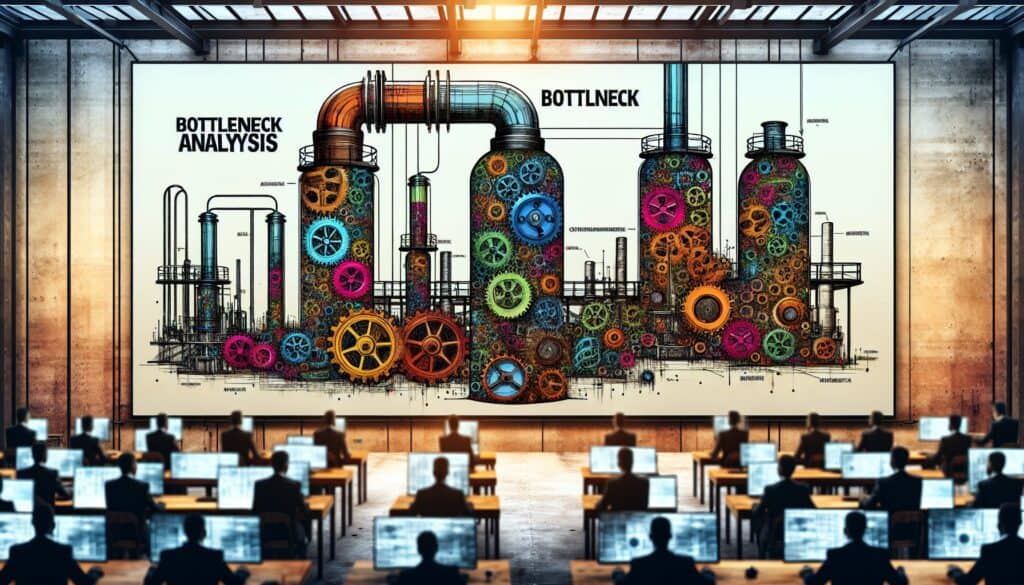确定流程中限制其总体能力或吞吐量的部分。
- 方法: 客户与营销, 构思, 产品设计
瓶颈分析

瓶颈分析
- 持续改进, 效率, 精益制造, 流程改进, 流程制图, 工艺优化, 生产率, 根本原因分析
目标
如何使用
- 包括绘制流程图,确定工作堆积或速度减慢的位置,并确定造成拥堵的根本原因。目标是提高瓶颈的效率,从而提高系统的整体性能。
优点
- 提高整体流程效率和生产率;有助于确定改进工作的优先次序;可降低成本,缩短周期时间。
缺点
- 找出真正的瓶颈有时会很复杂,尤其是在动态系统中;解决一个瓶颈可能会暴露出另一个瓶颈;解决方案可能需要投资或对流程进行重大调整。
类别
- 精益西格玛, 制造业, 解决问题, 项目管理
最适合:
- 通过识别和缓解系统中的制约因素,改善工艺流程,提高产量。
瓶颈分析法广泛应用于制造业、软件开发、医疗保健和物流等各行各业,这些行业的流程通常是线性和相互关联的。在制造业中,这种方法有助于识别装配线中导致延误的阶段,从而进行有针对性的干预,如机器升级或重新分配劳动力资源,以提高生产率。在软件开发中,瓶颈可能出现在代码集成或测试阶段,促使团队通过实施持续集成/持续部署(CI/CD)系统等工具来完善工作流程并改进协作实践。在医疗保健领域,瓶颈分析可以揭示病人流程中的低效问题,如急诊科的漫长等待时间,从而促使重新设计流程,优化人员分配和病人分流系统。计划通常从团队或部门内部开始,但也可受益于跨职能部门的参与,让管理层、一线员工和外部合作伙伴等利益相关者参与进来,从而全面了解流程及其限制因素。在分析阶段加强团队成员之间的沟通与协作,可以推动更有效的解决方案。实施瓶颈分析还可能涉及价值流图和因果图等工具,使团队能够直观地发现问题,并优先采取能产生最高效率和成本节约效益的行动。这种方法在项目早期阶段建立基准流程时尤为有利,可以为未来的改进设定基准,并在企业适应不断变化的市场条件或运营需求时促进其不断完善。
该方法的关键步骤
- 绘制当前流程图,详细说明每个步骤和涉及的资源。
- 确定工作堆积或出现延误的区域。
- 分析每个已识别瓶颈的根本原因。
- 根据影响和可行性,优先解决哪些瓶颈问题。
- 针对选定的瓶颈问题制定有针对性的解决方案。
- 实施解决方案并监测其效果。
- 必要时,通过重新评估和调整来迭代流程。
专业提示
- 利用模拟建模分析各种情况下工艺的潜在未来状态,帮助预测干预后的性能影响。
- 将直接参与瓶颈问题处理的操作人员的持续反馈回路纳入其中,以促进实时问题识别和创新解决方案。
- 采用多变量分析技术,探索不同流程要素之间的相互依存关系,从而深入了解表面症状之外的根本原因。
历史背景
1949
1950
1950
1960
1960
1960
1960
1940
1950
1950
1958
1960
1960
1960
1960
(如果日期不详或不相关,例如 "流体力学",则对其显著出现的时间作了四舍五入的估计)。















相关文章
蒙特卡罗模拟
基于模型的测试
型号检查
混合方法研究
防错(Poka-Yoke)
任务简介测试